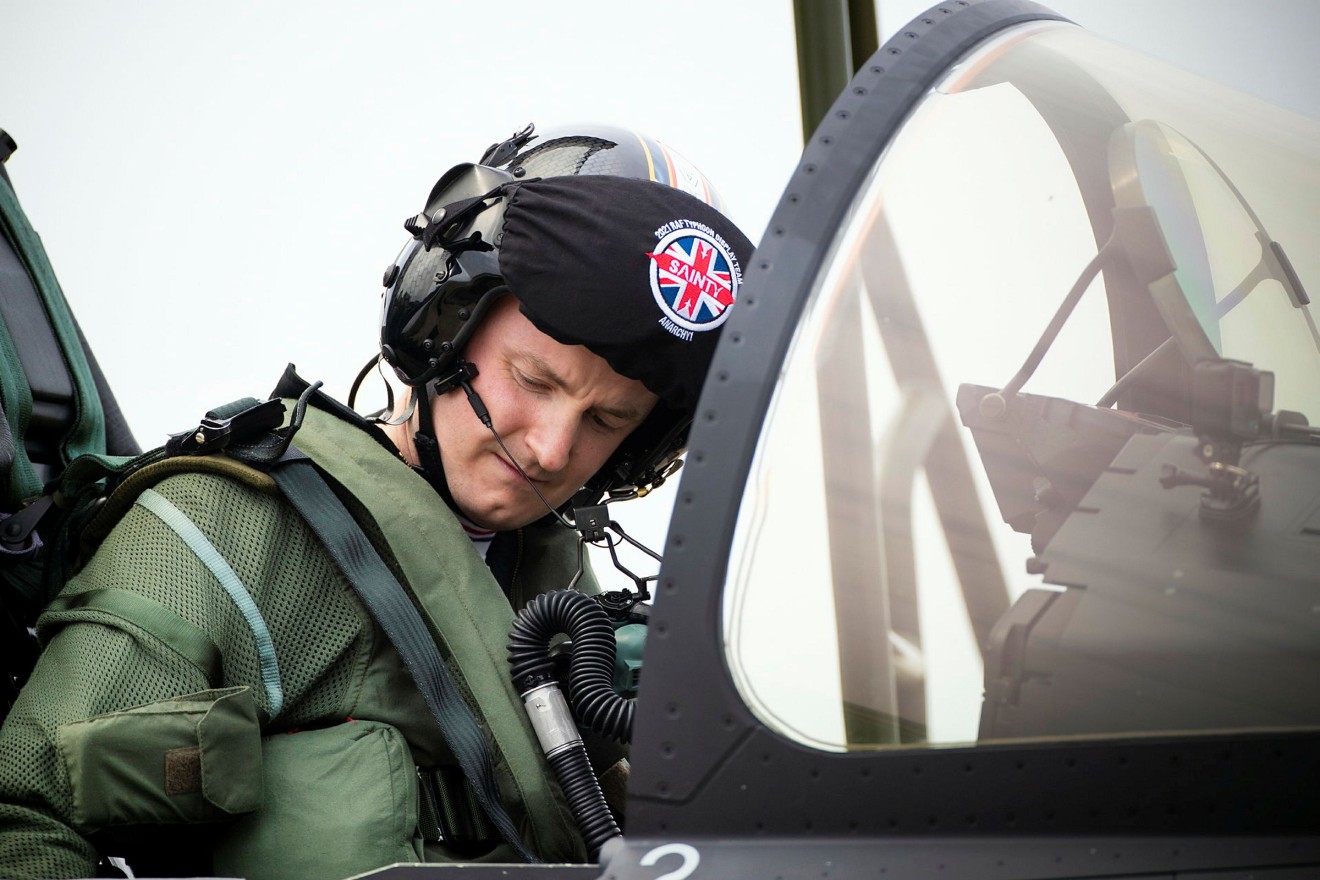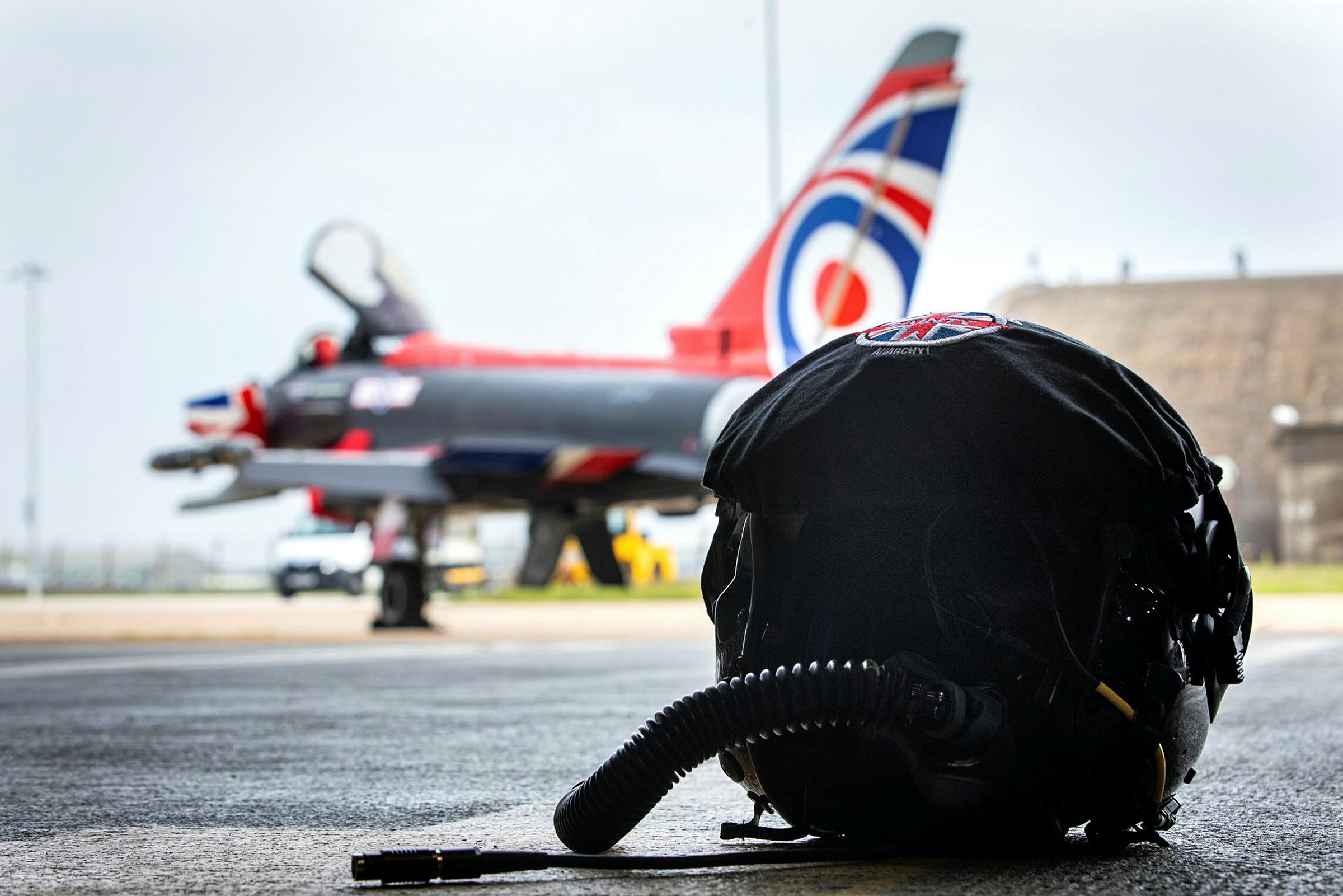
What inspired you to be a pilot?
I wanted to be a pilot after my father took me to Sunderland Air Show when I was nine years old. The whole air show was incredible, but it was the Red Arrows that I enjoyed the most. (Typhoon hadn’t come into service at that point.) From that point on I was hooked and my parents encouraged me. When I was 13, I joined the Air Cadets and was part of 242 Cramlington Air Cadets right up until age 18 when I joined the Air Force.
As a cadet I got into gliding and joined 645 Squadron Volunteer Gliding Squadron at Topcliffe. I flew a lot, became an instructor and started to teach other cadets. I actually flew solo before I could drive a car! Throughout school my focus was on one thing — I wanted to fly jets. Initially I wanted to be a Harrier pilot, but when they went out of service, I turned my attention to Typhoon.
How did your early RAF career develop?
I went through initial officer training in 2009 at Cramwell. After graduating I spent time on the 84 Squadron in Cyprus where I was very lucky to get an introduction to flying in the Griffin helicopter. I particularly enjoyed being thrown in the sea as a survivor and getting picked up by the helicopter!
When I returned to the UK, I started my flying training on the Grob Tutor on the 57 Squadron at RAF Wyton. I was then streamed to fast jets on 72 Squadron flying the Tucano. It’s there that I got my wings. My next posting was to the University of Southampton Flying Squadron. I was doing the same kind of job I used to do in the glider school but now in the Grob Tutor.
From there I joined cohort seven on the Hawk T2 at RAF Valley in 2014. While I was there I linked up with Typhoon HQ for six months, which cemented my ambition to fly the Typhoon. After completion of tactical weapons training, I was streamed to Typhoon in 2015.
Do you have any memories of your first flight in Typhoon?
Yes, my first flight was in a two-seater (today’s students do their first flight solo, which is incredible) and I was flying with a pilot called Brucie. When I released the brakes at the end of the runway the aircraft accelerated, I was thinking ‘Wow, this is quick’. Then Brucie said ‘You still need to select max power’. I was still only at 70 percent. After that it was a bit like in the movie The Fast and the Furious when he presses the nitrogen button, and everything goes blurry.
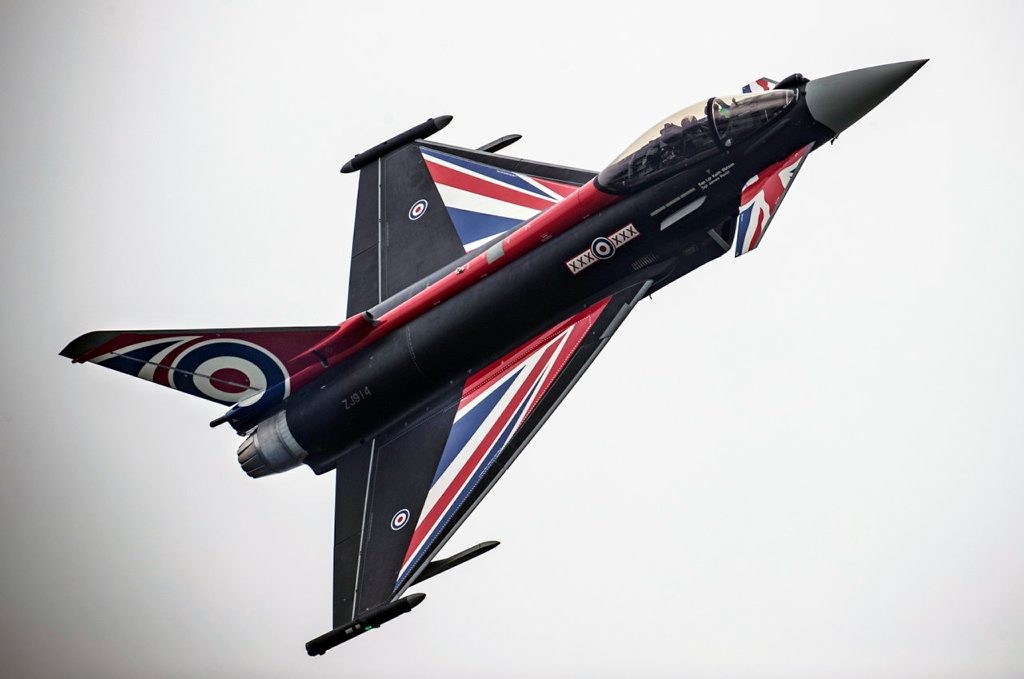
So what do you think of the aircraft?
Typhoon is extremely capable. Even in the time I've been on the jet, they've introduced a lot more capability. We've now got Storm Shadow, Brimstone and Paveway IV fully integrated and we've also started flying with Meteor.
In terms of capability, it’s a fast jet with phenomenal power, that can carry a lot of bombs and air-to-air weapons. It means you can fight your way in, hit the target and then fight your way out. It’s fully swing role now and has really come into its own in the last two or three to four years. It's really impressive.
And from a pilot’s perspective, how do you feel about being in the cockpit?
It's very easy to fly because it has to be. We don't have navigators anymore, so the pilot is more of a sensor operator. You don't want to worry about flying the aircraft and thankfully, it's got lots of automated systems that make our life easier. For example, the carefree handling element of the flight control system means I can move the control column into any position, at any speed and the jet physically will not let me overstress it. I can move the throttles with my left hand as much I want, I don't have to think too much about it because I'll never overstress the engines. And the jet will always give me power when I demand it. The engines are very reliable and extremely powerful.
Why do you think Typhoon impresses so much at air shows?
I think it's down to sheer power— it has greater than the one-to-one thrust ratio. It's so light and powerful that you can put the engines into reheat and the aircraft can accelerate vertically, which is an incredible feat.
The ability to pull 9G and combine it with raw speed means that you can keep the display really tight to the crowd lines. You've got the energy you need to be able to pull off manoeuvres very close to the crowd, they get a great view and it’s loud.
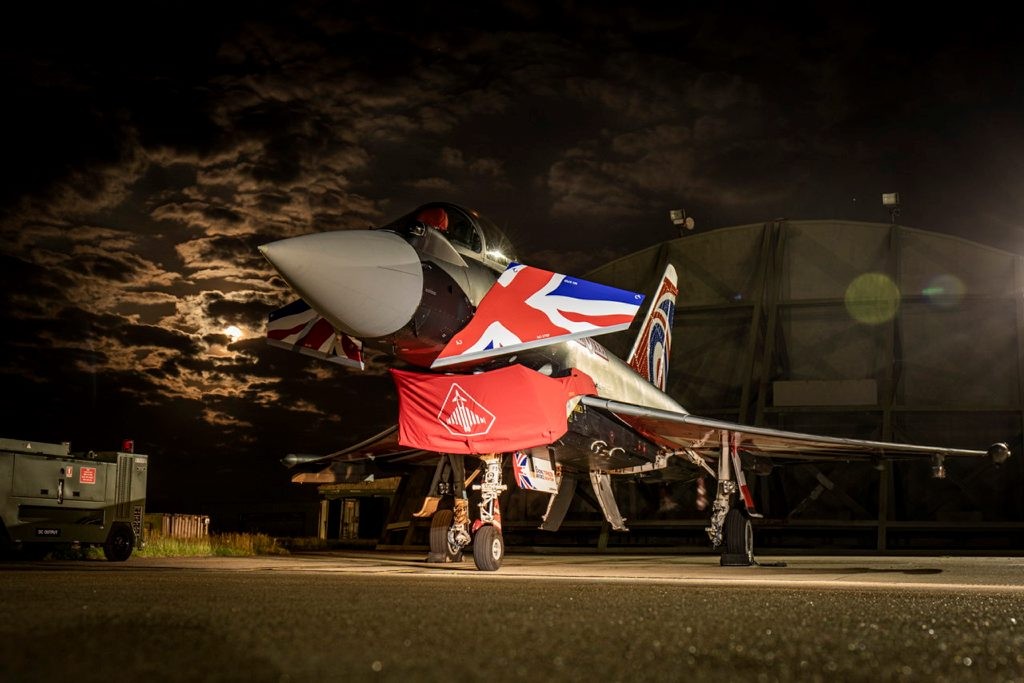
What is your advice if people are considering joining the Air Force?
The biggest piece of advice I'd give is don't listen to anyone who tells you there’s no point or that you might not be able to do it. You never know. Keep believing you can do it and go for it. That’s what I did — I had people who said I would never be a pilot. I just ignored them, went for it and did it. Get down to the careers office and tell them what you're interested in. They'll give you advice and a lot of information on how to apply.
What do you think are the key attributes to being a Typhoon pilot?
I think the biggest one is motivation. Flying Typhoon involves a lot of reading, research and learning throughout the seven, eight years it takes to train to be combat ready. During that time, there's a lot of data you've got to learn, plenty of reading material and checklists that you've got to memorise.
And even once you're qualified as a combat ready pilot, it doesn't stop there. Once you're on the Typhoon, there are upgrades to achieve — you can lead a two-ship or a four-ship. Then from there you can get professional qualifications as a flying instructor or a weapons instructor. You're constantly reading the books and learning new things about the aircraft.
That’s why I’d say motivation is the number one. Other key attributes you need are fitness and the ability to prioritise. There's a lot going on in the cockpit so that’s why prioritisation is important. You've got to be able to manage many different tasks at once and make sure that you're selecting the correct tasks at the right time.
And, of course, it’s also physically demanding as the jet can pull 9G and can roll very quickly. The physical effort of pulling 9G on numerous occasions can get quite tiring. The fitter you are, the better able you are to handle those sorts of forces.
What's the aspect of the job that you buzz off the most? What do you like best out of the role that you've chosen?
I particularly like being part of a team, working with the squadron. Away from the display flying I am an instructor and I like seeing the progress students make. I like it when they go flying for the first time and I get to see the smile on their faces when they return and hear them talk about how good it was and how much power the aircraft has. Then later down the line I see them when they are ready to leave the Operational Conversion Unit (OCU) and can see how proficient they have become before they go to the frontline. I get a kick out of that, seeing that they have learned something from the experience that I provide.
One of the most rewarding things is when you deploy on the front lines or on exercise. You then get a chance to work with a highly motivated team.
As a display unit are you part of a huge team?
Yes. We are nothing without the engineers, the logistics people, the suppliers, or the PR team — there is a whole chain of people without whom we would not be able to display. As a display pilot you have to be absolutely aware of the fact, that you are there representing the entire team. And everyone on the team wants to succeed and to produce the display. You're there just to deliver it. Without those key elements, I wouldn't be able to fly.
Is there a particular aspect of the display you have worked on?
My display will try to showcase the acceleration the jet has from slow to high speed and how much excess power it has. I’ll be demonstrating its ability to accelerate from slow speed and combine that with manoeuvres very close to the crowd line. There'll be a lot of noise and hopefully it will be awe-inspiring.
Are there past displays that you've drawn inspiration from or is this very much your fingerprint on it?
There are aspects of a few displays I’ve used, for example the entrance from the 2016 display, but I have put my own twist on. There are also a couple of aspects from Jim Peterson’s 2019 display, particularly the high-speed barrel roll. In terms of things that I am bringing to the display, there’s something that I am calling the ‘Derry Rectangle’. It starts with a Derry turn and comprises a lot of rolling around a rectangle shape, it all takes place very close to the crowd line and I hope it will look cool from the ground.
What kind of weather do you feel is optimum for displaying?
I was fortunate enough to be the spare pilot for Jim Peterson’s Friday evening show at Sunderland Air Show a couple of years back. I think the light at sunset is ideal because it really brings out the afterburners from the back of the engines. It looks absolutely incredible. High moisture days are good too. You can make your own clouds when you're pulling G with a high alpha. I think that it’s really cool when the Typhoon disappears into its own cloud.
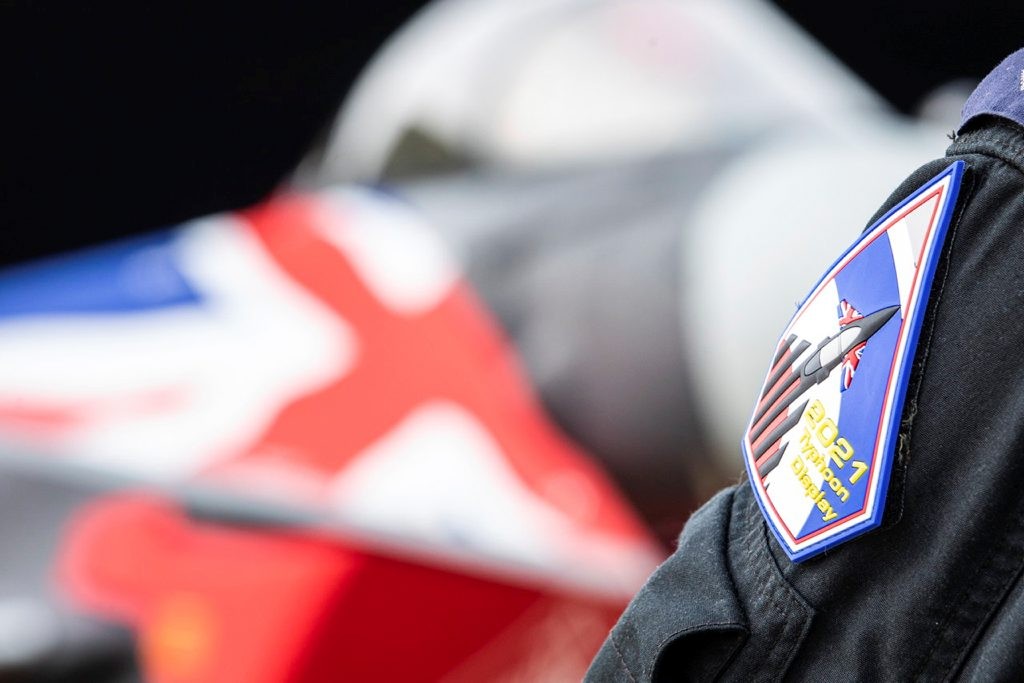
What kind of preparation takes place behind the scenes in the month before the display season?
The display work starts in February. The first few will be flown at 5000 ft to prove I have the manoeuvres in my head and that I'm sticking to the height and speed limits. There are a minimum of six displays at 5000 ft before I can safely bring it down to a lower level. I go down to 1500 ft, then 1000 ft for six more flights at each height before I am declared good to fly at low level. That involves carrying out the full display at a minimum of 500 ft for the aerobatic elements.
The lowest I'm allowed to fly is 100 ft and the highest will be about 4,000 ft. At the same time I'll also be carrying out a lot of simulator flying with my mentor Mark Long, the 2016 display pilot. He sits in the simulator with me, checking my flying manoeuvres, making sure they are carried out correctly and safely. Obviously, there's a lot of emphasis on safety.
Is display flying physically demanding?
My display is around eight minutes long — I burn just under three tons of fuel and pull 9G on numerous occasions. So, yes, by the time I have flown the full display, it's physically quite exhausting. I wouldn’t want to do much more than eight minutes.
What's the day-to-day routine like during the display season?
We deploy two jets to the air show — we have a spare aircraft in case there are any snags. On the day of the display our engineers go in early to prepare the aircraft, running through their checklists and making sure everything is safe. There’s potential for me to do some PR in the morning, then I'll go to the airfield.
After the display it depends on the programme. I might be signing autographs and doing some more PR activity, or I might have to do a show at a different event. If that's the case, I'll need about two and half hours on the ground before going again. I’m limited to three displays a day.
What attracted you to this display pilot role?
It was a chance to represent the Air Force and Typhoon force. I've been very lucky over the past five years with what I have achieved on the frontline. I have been to two Red Flags in Las Vegas, deployed on operations in Iraq and Syria twice. I've been to the Falklands three times, to Oman twice, where I took part in Exercise Magic Carpet. I have also been to Langley on the east coast of America.
During that time, I've been very lucky to be picked on some of the best exercises in the world. Now I have the opportunity to inspire people and motivate them to join up. It's a massive privilege. It’s also an opportunity to fly the jet at the limit of its envelope at low level. I’m sure it will be some of the most incredible flying I’ve ever done.
Images: UK MOD © Crown copyright 2021
